
 The United States Highway Sign
The United States Highway Sign
 The United States Highway Sign
The United States Highway Sign![]()
U.S. Numbered Highways have used the same basic shield since before the numbering scheme was agreed upon. Fornmally, it is called the six point shield, five points above, one below.
1925:  The preliminary design was first proposed
April 20, 1925, the same day the Joint Board on Interstate
Highways decided that a numbering system would be preferable to
names. Leo Boulay of Ohio suggested using the official United
States shield and the designation 'U.S.A.'. The shield had been
in use by the U.S. government in various forms since the late
1700's and a version of it can be found on the backs of modern American
currency, the $1.00 bill.
The preliminary design was first proposed
April 20, 1925, the same day the Joint Board on Interstate
Highways decided that a numbering system would be preferable to
names. Leo Boulay of Ohio suggested using the official United
States shield and the designation 'U.S.A.'. The shield had been
in use by the U.S. government in various forms since the late
1700's and a version of it can be found on the backs of modern American
currency, the $1.00 bill. 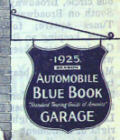 Automobile
Blue Books, Inc. of Chicago, Illinois used a blue variant of the
US shield with white lettering to endorse Hotels, Garages,
Restaurants, Tea Rooms, and Inns in the 1920's. The Automobile
Blue Book shield shown is from Vol. 2, published 1925. The first
plan was to use the basic shape of the official US shield as the
route marker with the addition of "U.S.A." and a route
number. An early debate on color schemes was between yellow with
black numbers (C.M. Babcock of Minnesota) and white with black
numbers. Yellow offered better winter and snow visibility, but
the color was also being proposed for use with several other road
signs at the time, all related to road hazards. The color white
was decided upon for the US shield. Colonel Frederick S. Greene
of New York also noted that if you put a black border around the
white sign, "it acts perfectly."
Automobile
Blue Books, Inc. of Chicago, Illinois used a blue variant of the
US shield with white lettering to endorse Hotels, Garages,
Restaurants, Tea Rooms, and Inns in the 1920's. The Automobile
Blue Book shield shown is from Vol. 2, published 1925. The first
plan was to use the basic shape of the official US shield as the
route marker with the addition of "U.S.A." and a route
number. An early debate on color schemes was between yellow with
black numbers (C.M. Babcock of Minnesota) and white with black
numbers. Yellow offered better winter and snow visibility, but
the color was also being proposed for use with several other road
signs at the time, all related to road hazards. The color white
was decided upon for the US shield. Colonel Frederick S. Greene
of New York also noted that if you put a black border around the
white sign, "it acts perfectly."  Colonel Greene objected to the use of
"U.S.A.", favoring "T.C." for
"Trans-continental", his personal vision of the US
Numbered Highway System. Colonel Greene favored an extremely
limited amount of routes, with a strong emphasis on those routes
being transcontinental in nature, much like the Eisenhower
Interstate System in modern times. His naming suggestion was
rejected in favor of the appellation "U.S.". New York
State still ended up bearing the brunt of his numbering ideas.
Many planned three-digit US numbered highways like US 220 end up
with termini at the NY state line because these shorter branch
routes did not follow Col. Greene's vision. If he had acceded to
the direction route numbering was taking, it is possible these
routes would have been extended to a US route across southern New
York, possibly a rerouted US 6. US 6 in Pennsylvania might have
been part of extended routes US 106 and US 120. On August 3,
1925, AASHO dropped the state name from the proposed shield to
add emphasis to the U.S. part. Many states balked at this and on
August 4, 1925, the state name was reinstated, and the
"State" "US" "number" format
formally adopted. The first US shield actually fabricated as an
example was the then-unused number '56' with the state of Maine
(See above left). *** Ron Wilbanks has
information attributing the final choice of design for the US
Highway shield in 1926 to a design by Mr. Frank Cnare, who worked
for the Wisconsin State Highway Dept. Mr. Cnare has a flair for
drawing, and his design beat out the other 48 states hands down.
His design used the U.S.D.A. logo in a very tasteful way that
appealed to them very much. *** (Perhaps he provided the finalization of the planned
design? - RVD)
Colonel Greene objected to the use of
"U.S.A.", favoring "T.C." for
"Trans-continental", his personal vision of the US
Numbered Highway System. Colonel Greene favored an extremely
limited amount of routes, with a strong emphasis on those routes
being transcontinental in nature, much like the Eisenhower
Interstate System in modern times. His naming suggestion was
rejected in favor of the appellation "U.S.". New York
State still ended up bearing the brunt of his numbering ideas.
Many planned three-digit US numbered highways like US 220 end up
with termini at the NY state line because these shorter branch
routes did not follow Col. Greene's vision. If he had acceded to
the direction route numbering was taking, it is possible these
routes would have been extended to a US route across southern New
York, possibly a rerouted US 6. US 6 in Pennsylvania might have
been part of extended routes US 106 and US 120. On August 3,
1925, AASHO dropped the state name from the proposed shield to
add emphasis to the U.S. part. Many states balked at this and on
August 4, 1925, the state name was reinstated, and the
"State" "US" "number" format
formally adopted. The first US shield actually fabricated as an
example was the then-unused number '56' with the state of Maine
(See above left). *** Ron Wilbanks has
information attributing the final choice of design for the US
Highway shield in 1926 to a design by Mr. Frank Cnare, who worked
for the Wisconsin State Highway Dept. Mr. Cnare has a flair for
drawing, and his design beat out the other 48 states hands down.
His design used the U.S.D.A. logo in a very tasteful way that
appealed to them very much. *** (Perhaps he provided the finalization of the planned
design? - RVD)
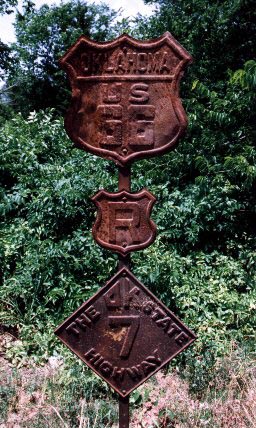 Late
1920's - Mid 1940's: In "American Highways"
April 1927, Vol. VI No. 2, the sign approved for the US numbered
highway system was described thusly: "The design adopted is
the commonly known United States shield outline, and this shield
carries the route number, as well as the State name through which
the road passes." The chosen size for the US highway shields
was approximately 18" x 18". US Markers in the early
days were made of 16 gauge heavy embossed steel (although some
states did use very heavy cast iron in place of the steel). This
sign featured the state name on the top cavity, and
"US" and the highway number on the bottom. Early US
signs were supposed to be all in block letters, but some curves
snuck in, like the 'S' in the rusty old US 66 on the right side
of the page. This US 66 picture is courtesy Jim Ross, who either
found the sign in a scrap metal pile or knows the person who did.
Late
1920's - Mid 1940's: In "American Highways"
April 1927, Vol. VI No. 2, the sign approved for the US numbered
highway system was described thusly: "The design adopted is
the commonly known United States shield outline, and this shield
carries the route number, as well as the State name through which
the road passes." The chosen size for the US highway shields
was approximately 18" x 18". US Markers in the early
days were made of 16 gauge heavy embossed steel (although some
states did use very heavy cast iron in place of the steel). This
sign featured the state name on the top cavity, and
"US" and the highway number on the bottom. Early US
signs were supposed to be all in block letters, but some curves
snuck in, like the 'S' in the rusty old US 66 on the right side
of the page. This US 66 picture is courtesy Jim Ross, who either
found the sign in a scrap metal pile or knows the person who did.![]() The sign is authentic, and was probably posted in
1926. It used to stand in Chandler, Oklahoma, facing westbound
traffic before a hard right turn in front of what is now (1999)
PJ's Barbecue. The post assembly was probably removed in 1930,
when OK 7 was moved. The first US shields posted in 1926 and 1927
indicated left and right turns in the numbered route by R's and
L's in smaller US shields. Many states kept to a similar practice
into the 1930's, I have see an old picture with a small cut-out
Virginia state route shield with a "R" inside it. Today
we place just place arrows underneath the shield.
The sign is authentic, and was probably posted in
1926. It used to stand in Chandler, Oklahoma, facing westbound
traffic before a hard right turn in front of what is now (1999)
PJ's Barbecue. The post assembly was probably removed in 1930,
when OK 7 was moved. The first US shields posted in 1926 and 1927
indicated left and right turns in the numbered route by R's and
L's in smaller US shields. Many states kept to a similar practice
into the 1930's, I have see an old picture with a small cut-out
Virginia state route shield with a "R" inside it. Today
we place just place arrows underneath the shield.

 "City" U.S. Highway
Shields: There was a second type of early US shield,
approved for 'city' use. It was smaller, at around eleven inches
high and wide (11" x 11") as these two 1939 pictures
show. The smaller city-use signs dropped the state name, and only
placed US in the banner area that was formerly reserved for the
state name. One example of this is the sign tree for US 77, US
81, US 84, TX 67 "BUSINESS ROUTE" that used to be
posted in Waco, Texas (See left). Bannered US routes started
coming into wide usage after the September 1934 AASHO meeting.
Prior to that, a suffix of T had been used to denote Temporary
routes, a designation that continues to be acceptable to this day
as TEMP. Another set of early banner routes were the US 27A's of
1933 in Central Michigan, which became ALTERNATE US 27's, and now
are Business US 27s, until they become Business US 127's. AASHO's
strong dislike for split US routes with directional letter
suffixes, like US 31E and US 11W, almost resulted in US 37 and US
143 being signed in Kentucky and Tennnessee. AASHO actually
approved both new numbers, but the states preferred the suffixes
which remain today.
"City" U.S. Highway
Shields: There was a second type of early US shield,
approved for 'city' use. It was smaller, at around eleven inches
high and wide (11" x 11") as these two 1939 pictures
show. The smaller city-use signs dropped the state name, and only
placed US in the banner area that was formerly reserved for the
state name. One example of this is the sign tree for US 77, US
81, US 84, TX 67 "BUSINESS ROUTE" that used to be
posted in Waco, Texas (See left). Bannered US routes started
coming into wide usage after the September 1934 AASHO meeting.
Prior to that, a suffix of T had been used to denote Temporary
routes, a designation that continues to be acceptable to this day
as TEMP. Another set of early banner routes were the US 27A's of
1933 in Central Michigan, which became ALTERNATE US 27's, and now
are Business US 27s, until they become Business US 127's. AASHO's
strong dislike for split US routes with directional letter
suffixes, like US 31E and US 11W, almost resulted in US 37 and US
143 being signed in Kentucky and Tennnessee. AASHO actually
approved both new numbers, but the states preferred the suffixes
which remain today.  This "CITY
ROUTE"' US 12 shield was posted in Chicago, Illinois. The 45
M.P.H. speed limit had been defaced at the time of the picture,
showing that speed limits were unpopular with some people even
then. One hundred and forty-eight miles per hour does seem a bit
extreme for an urban highway. This highway this sign was posted
along was mainline US 12 until 1938, so the US shield shown is
fairly new. Note the bannering in the "state" portion
of the shield on City 12 and Business 66, and a different plate
on the Waco assembly. Auxillary banner signs for road types did
not come into wide use until the 1960's.
This "CITY
ROUTE"' US 12 shield was posted in Chicago, Illinois. The 45
M.P.H. speed limit had been defaced at the time of the picture,
showing that speed limits were unpopular with some people even
then. One hundred and forty-eight miles per hour does seem a bit
extreme for an urban highway. This highway this sign was posted
along was mainline US 12 until 1938, so the US shield shown is
fairly new. Note the bannering in the "state" portion
of the shield on City 12 and Business 66, and a different plate
on the Waco assembly. Auxillary banner signs for road types did
not come into wide use until the 1960's.
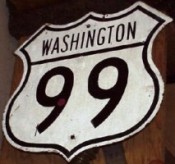 Mid 1940's - Mid
1950's: In the 1943 Ohio MUTCD, they recommended the
use of the "M-101" which was an outline of a US Marker
on a white background, using a square sign instead of the
traditonal cut-out shields. This subsequently was carried over
into the National 1948 MUTCD, which changed the use of the
embossed "squared off" lettering and numerals.
Mid 1940's - Mid
1950's: In the 1943 Ohio MUTCD, they recommended the
use of the "M-101" which was an outline of a US Marker
on a white background, using a square sign instead of the
traditonal cut-out shields. This subsequently was carried over
into the National 1948 MUTCD, which changed the use of the
embossed "squared off" lettering and numerals.  They recommended the use of a
16 " x 16" size standard marker, and the larger
24" x 24" "oversize" marker, for use at
junctions and turns. In 1950 a new design was introduced by
Illinois that featured the state name across the top, a divider
line on a 16" x 16" cutout, and removing the
"US" and using larger numerals on the sign. This design
was very popular in the Plains states as well, including Texas.
In 1953, AASHO put their foot down and required the
"US" be placed back on the signs.
They recommended the use of a
16 " x 16" size standard marker, and the larger
24" x 24" "oversize" marker, for use at
junctions and turns. In 1950 a new design was introduced by
Illinois that featured the state name across the top, a divider
line on a 16" x 16" cutout, and removing the
"US" and using larger numerals on the sign. This design
was very popular in the Plains states as well, including Texas.
In 1953, AASHO put their foot down and required the
"US" be placed back on the signs. This lead to yet another design change in
1954, when Ohio, and many of the eastern states decided to place
an abbreviation and the US on the top line of the sign and remove
the divider line. Examples were "OHIO-US",
"MASS-US, "CONN-US, "D.C.-US",
"MISS-US", "TENN-US" etc. By way of contrast,
both the Carolinas went as far as to spell out "UNITED
STATES" using series "A" on the top of their
signs, however, this design was very short lived as well, because
series "A" is very hard to read. (I'm
looking for pictures of these. Let me know if you find any.)
This lead to yet another design change in
1954, when Ohio, and many of the eastern states decided to place
an abbreviation and the US on the top line of the sign and remove
the divider line. Examples were "OHIO-US",
"MASS-US, "CONN-US, "D.C.-US",
"MISS-US", "TENN-US" etc. By way of contrast,
both the Carolinas went as far as to spell out "UNITED
STATES" using series "A" on the top of their
signs, however, this design was very short lived as well, because
series "A" is very hard to read. (I'm
looking for pictures of these. Let me know if you find any.)
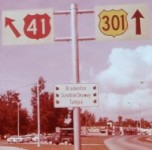 Mid 1950's: In the 1950's, a new Manual of
Uniform Traffic Control Devices (MUTCD) changed the approved
color for stop signs from black lettering on a yellow background
to the now-familiar red background with white lettering. It
apparently also authorized dropping the in-shield bannering,
leaving just a number inside the US shield shape. Colors were
not directly specified. Some states took the opportunity to
change the color of the US highway shield as well. Washington,
D.C. experimented with this in 1952. The state of Florida went
the furthest with this idea, and started color-coding all its US
shields in 1956. This resulted in odd colors like orange for US
41 and yellow for US 301 as shown in the picture on the left. FHWA was and still is is
willing to let FDOT
post colored US shields, as long as it is all Florida funded. Any
US shield placed with the asistance of federally collected gas
tax money must conform to the most recent MUTCD. Throughout the
1980's, FDOT maintenance crews replaced new black on white US
signs on new projects with FDOT color scheme equivalents. FDOT
finally decided the expense of the experiment was too great, and
ceased making new colored US shields August 12, 1993. New and
replaced US highway signs are the standard black numbers on white
background. Vesitiges of the old coloring scheme remain,
primarily in urban areas. Due to Florida's aggressive sign
replacement policy, you can expect them all replaced by 2005.
Most were removed by 2000, a few stragglers on side streets and
overhead signs remain.
Mid 1950's: In the 1950's, a new Manual of
Uniform Traffic Control Devices (MUTCD) changed the approved
color for stop signs from black lettering on a yellow background
to the now-familiar red background with white lettering. It
apparently also authorized dropping the in-shield bannering,
leaving just a number inside the US shield shape. Colors were
not directly specified. Some states took the opportunity to
change the color of the US highway shield as well. Washington,
D.C. experimented with this in 1952. The state of Florida went
the furthest with this idea, and started color-coding all its US
shields in 1956. This resulted in odd colors like orange for US
41 and yellow for US 301 as shown in the picture on the left. FHWA was and still is is
willing to let FDOT
post colored US shields, as long as it is all Florida funded. Any
US shield placed with the asistance of federally collected gas
tax money must conform to the most recent MUTCD. Throughout the
1980's, FDOT maintenance crews replaced new black on white US
signs on new projects with FDOT color scheme equivalents. FDOT
finally decided the expense of the experiment was too great, and
ceased making new colored US shields August 12, 1993. New and
replaced US highway signs are the standard black numbers on white
background. Vesitiges of the old coloring scheme remain,
primarily in urban areas. Due to Florida's aggressive sign
replacement policy, you can expect them all replaced by 2005.
Most were removed by 2000, a few stragglers on side streets and
overhead signs remain.
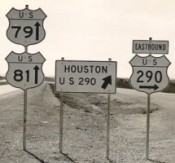 You can see photos of
Florida's unique colored US signs at James
Lin's website and my Florida in
Kodachrome site. Kansas
experimented with a new color, green, on the newly assigned US
56. Arizona
(map)
experimented with directional coloring in the 1950's and 1960's. Mississippi colored
some shields in a scheme similar to Florida's, but possibly only
in cities. Washington
State experimented with directional-colored US shields in
urban areas in the 1950's. Rhode Island reportedly experimented
with a red and white US 1 sign like Florida's. Wisconsin also
utilized colored US signs, Business / City US signs were yellow
(Like in Janesville,
WI in 1999), and WisDOT also may have used green and / or
pink on US signs, per discussions on misc.transport.road.
You can see photos of
Florida's unique colored US signs at James
Lin's website and my Florida in
Kodachrome site. Kansas
experimented with a new color, green, on the newly assigned US
56. Arizona
(map)
experimented with directional coloring in the 1950's and 1960's. Mississippi colored
some shields in a scheme similar to Florida's, but possibly only
in cities. Washington
State experimented with directional-colored US shields in
urban areas in the 1950's. Rhode Island reportedly experimented
with a red and white US 1 sign like Florida's. Wisconsin also
utilized colored US signs, Business / City US signs were yellow
(Like in Janesville,
WI in 1999), and WisDOT also may have used green and / or
pink on US signs, per discussions on misc.transport.road.
Another interesting design for US Route Markers was used in the
state of Texas from 1954 - 1968. They used a standard 20" x
20" size marker and a larger 24" x 24" size marker
where greater visibility was required. However, the most unique
feature of their signs was the direction, turn, and trailblazer,
24" x 24" size markers they used. The signs were laid
out with the "US" across the top, a divider line, then
the numerals. Beside the numerals were a variety of arrows to
indicate directions and turns of the route, or how to reach it.
 Today:
The states of California and Virginia still use cut-out US
shields, as opposed to the standard approved black square with a
white shield. California even places US on some shields. The six
point US highway shield is still the highly recognizable symbol
of the road system that binds the country together, from doorstop
to doorstop. US 66 was decommissioned in 1985. There has been
such a demand to follow the old route between Chicago and Los
Angeles that "Historic US 66" brown and white US type
shields are being posted in increasing numbers. The affection for
the old road along the interstate is such that the states along
the route have to protect the remaining original US shields from
souvenir hunters and collectors.
Today:
The states of California and Virginia still use cut-out US
shields, as opposed to the standard approved black square with a
white shield. California even places US on some shields. The six
point US highway shield is still the highly recognizable symbol
of the road system that binds the country together, from doorstop
to doorstop. US 66 was decommissioned in 1985. There has been
such a demand to follow the old route between Chicago and Los
Angeles that "Historic US 66" brown and white US type
shields are being posted in increasing numbers. The affection for
the old road along the interstate is such that the states along
the route have to protect the remaining original US shields from
souvenir hunters and collectors.  Arizona
had a brief problem with the new "Historic US 66" being
stolen. Legally, US Route 66 may have been decommissioned, but it
has stayed in the hearts of those who lived and worked along its
mostly two-lane alignment, and it stayed in the conciousness of
America. The familiar US shield shape is even being painted on
the asphalt in some areas of Old 66. Today the State of
California is also using a modified US shield to unofficially
bring back US 99 and sections of US 101 decommissioned in 1964.
Arizona decomissioned or truncated many US routes in 1993, then
reposted brown "Historic" shields on sections a few
years later. The success of the use of green in Interstate
business routes has led to the posting of a few US business
routes with green shields.
Arizona
had a brief problem with the new "Historic US 66" being
stolen. Legally, US Route 66 may have been decommissioned, but it
has stayed in the hearts of those who lived and worked along its
mostly two-lane alignment, and it stayed in the conciousness of
America. The familiar US shield shape is even being painted on
the asphalt in some areas of Old 66. Today the State of
California is also using a modified US shield to unofficially
bring back US 99 and sections of US 101 decommissioned in 1964.
Arizona decomissioned or truncated many US routes in 1993, then
reposted brown "Historic" shields on sections a few
years later. The success of the use of green in Interstate
business routes has led to the posting of a few US business
routes with green shields.
 Should we change the US highway shield?
Should we change the US highway shield?
The shape itself is one of the most
recognizable symbols in the nation, but it does not have popular,
flashy coloring like the blue, white, and red of the Interstates.
Click here to see my ideas to liven it up.
There are also
some great concepts at "Highway Makeover"
References :
"From Names to Numbers: The Origins of the U.S. Numbered
Highway System" by Richard F.
Weingroff, FHWA Information Liason Specialist, published in AASHTO
Quarterly, Spring 1997.
American Highways April 1927, Vol. VI No. 2
Florida: Trails to Turnpikes 1919-1964 by Baynard
Kendrick, 1964
Older MUTCD information, especially about the smaller 'city use'
US shields, and the wonderful 66 shield, Bob Ross
A great deal of the US shield information, the Texas 1950's
picture, the Ohio-US, the Business 66, Kansas 24 and Washington
99 - Ron Wilbanks - you could even say he wrote much of this
page.
If you want to see a fraction of an incredible US highway sign
collection, enough to make your jaw drop, look here: http://members.ebay.com/aboutme/us_rte_shields/
Other photographs from my personal collection, FDOT archives, and
the Library of Congress
photographic archive.
If you any have thoughts, comments, additions, suggestions, E-mail me or post it to the misc.transport.road newsgroup.
If you want to buy a US Highway Sign, check out USA Traffic Signs
![]() U.S. Highways :
From US 1 to (US 830)
U.S. Highways :
From US 1 to (US 830)
Site created and maintained by
Robert V. Droz
Last update to this page on Friday, May 30, 2008